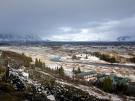|
|
 |
Surtsey, one of the newest
islands on earth, is found in the waters to the southeast of Iceland.
|
 |
On the 14th of November 1963 seamen,
that were fishing about 20km southwest of Heimaey observed the beginnings of an undersea eruption
that originated at a 130 metre depth.
An island eventually rose to a height of 169 metres above sea level that
had an area of 2,5km². This island was named Surtsey for Surtur, the fire possessing giant of Norse
mythology who would set fire to the earth at the Last Judgment.
For three and a half years Surtsey
rumbled and lava flowed. Long before the eruption stopped the island was proclaimed a nature preserve and all
travel there was restricted to scientist that used this unique opportunity to study the gradual development
of life on a sterile landmass.
The first living found in the ash deposits close to shore. In May of the same
year a fly was found on the island. Sea gulls visited the tide waters furthest from creter. The first
vascular plant to flower along the shore was the sea rocket, observed in 1965.
By 1987, twenty-five
species of higher plants had been observed, transported there by seed in the sea currents, some from
nearby island, other from the southern Icelandic coast 40 kilometres off. Other species of plants
have been carried there by yhe winds or birds from Europe.
Surtsey is a favorite resting place for migratory
birds during seasonal flights to and from Iceland and Europe. They visit there yearly by the thousands. Seals
also visit the island and relax on its beaches.
Today five species of birds nest on Surtsey: the Herring Gull,
the Black Backed Gull, the Black Guillemot, The Kittiwake and Fulmar which was
the first species
to nest there and hatch its young on the warm lava in 1970
|
 |
|
|
|
Enter supporting content here
Feedback, submissions, ideas? Email svanurg@gmail.com
|
|
|
 |

